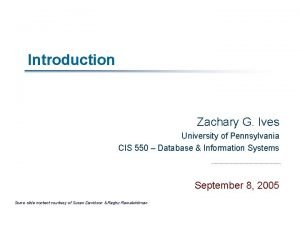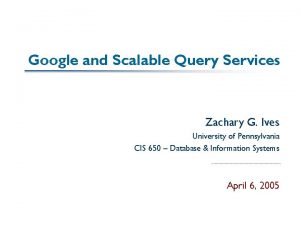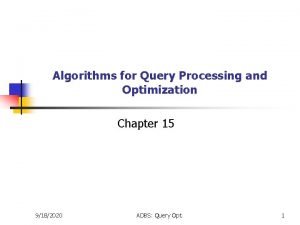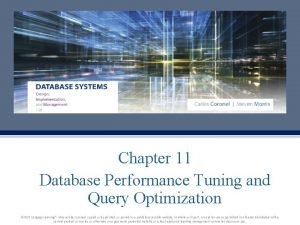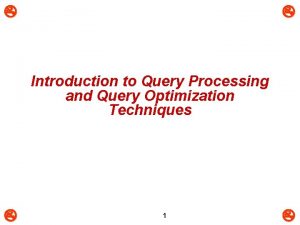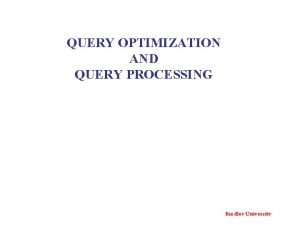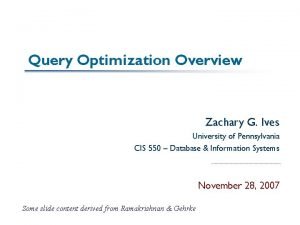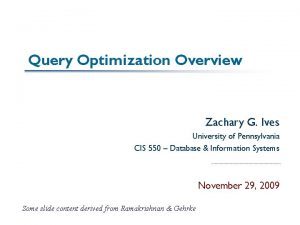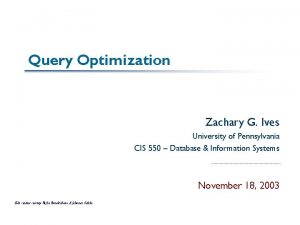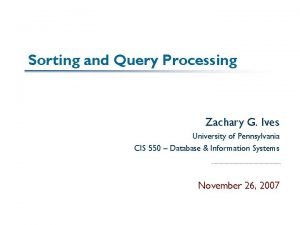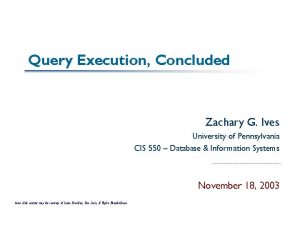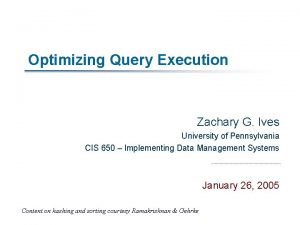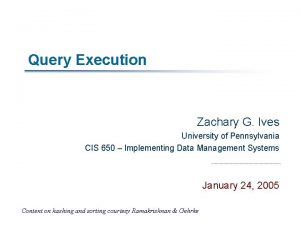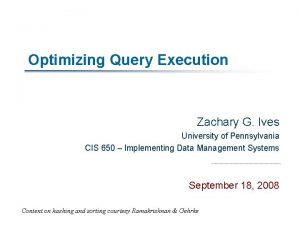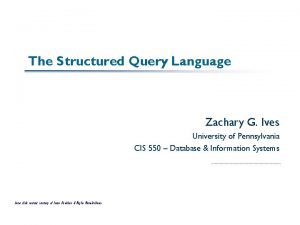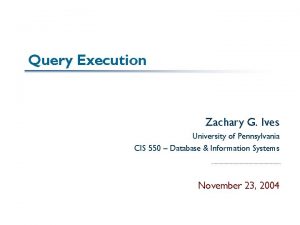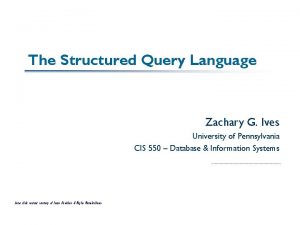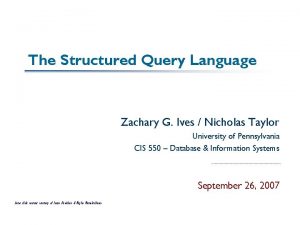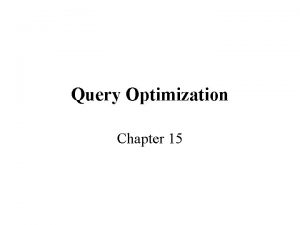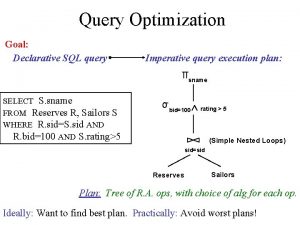Query Optimization Overview Zachary G Ives University of





















- Slides: 21

Query Optimization Overview Zachary G. Ives University of Pennsylvania CIS 550 – Database & Information Systems December 2, 2004 Some slide content derived from Ramakrishnan & Gehrke

Reminders § Homework 7 due Tuesday § Project demos will be on the 15 th and 16 th – along with a 5 -10 page report describing: § § What your project goals were What you implemented Basic architecture and design Division of labor 2

Overview of Query Optimization § A query plan: algebraic tree of operators, with choice of algorithm for each op § Two main issues in optimization: § For a given query, which possible plans are considered? Algorithm to search plan space for cheapest (estimated) plan § How is the cost of a plan estimated? § Ideally: Want to find best plan § Practically: Avoid worst plans!

The System-R Optimizer: Establishing the Basic Model § Most widely used model; works well for < 10 joins § Cost estimation: Approximate art at best § Statistics, maintained in system catalogs, used to estimate cost of operations and result sizes § Considers combination of CPU and I/O costs § Plan Space: Too large, must be pruned § Only the space of left-deep plans is considered Left-deep plans allow output of each operator to be pipelined into the next operator without storing it in a temporary relation § Cartesian products avoided

Schema for Examples Sailors (sid : integer, sname : string, rating : integer, age : real) Reserves (sid : integer, bid : integer, day : dates, rname : string) § Reserves: § Each tuple is 40 bytes long, 100 tuples per page, 1000 pages. § Sailors: § Each tuple is 50 bytes long, 80 tuples per page, 500 pages.

Query Blocks: Units of Optimization § An SQL query is parsed into a collection of query blocks , and these are optimized one block at a time. § Nested blocks are usually treated as calls to a subroutine, made once per outer tuple. § SELECT S. sname FROM Sailors S WHERE S. age IN (SELECT MAX (S 2. age) FROM Sailors S 2 GROUP BY S 2. rating ) Outer block Nested block For each block, the plans considered are: – All available access methods, for each reln in FROM clause. – All left-deep join trees (i. e. , all ways to join the relations one-at-a -time, with the inner reln in the FROM clause, considering all reln permutations and join methods. )

Relational Algebra Equivalences § Allow us to choose different join orders and to `push’ selections and projections ahead of joins. § Selections : c 1^…^cn (R) ´ c 1(… cn (R)) (Cascade) c 1( c 2(R)) ´ c 2( c 1(R)) (Commute ) v Projections : a 1 (R) ´ a 1 (…( an (R)))) v Joins : R ⋈ (S ⋈ T) (R ⋈ S) ⋈ T (R ⋈ S) (S ⋈ R) Ø Show that: R ⋈ (S ⋈ T) (T ⋈ R) ⋈ S (Associative) (Commute)

More Equivalences § A projection commutes with a selection that only uses attributes retained by the projection § Selection between attributes of the two arguments of a cross-product converts cross-product to a join § A selection on ONLY attributes of R commutes with R ⋈ S: (R ⋈ S) (R) ⋈ S § If a projection follows a join R ⋈ S, we can “push” it by retaining only attributes of R (and S) that are needed for the join or are kept by the projection

Enumeration of Alternative Plans § There are two main cases: § § Single-relation plans Multiple-relation plans § For queries over a single relation, queries consist of a combination of selects, projects, and aggregate ops: § § Each available access path (file scan / index) is considered, and the one with the least estimated cost is chosen. The different operations are essentially carried out together (e. g. , if an index is used for a selection, projection is done for each retrieved tuple, and the resulting tuples are pipelined into the aggregate computation).

Cost Estimation § For each plan considered, must estimate cost: § Must estimate cost of each operation in plan tree. Depends on input cardinalities. § Must also estimate size of result for each operation in tree! Use information about the input relations. For selections and joins, assume independence of predicates.

Cost Estimates for Single-Relation Plans § Index I on primary key matches selection: § Cost is Height(I)+1 for a B+ tree , about 1. 2 for hash index. § Clustered index I matching one or more selects: § (NPages(I)+NPages(R )) * product of RF’s of matching selects. § Non-clustered index I matching one or more selects: § (NPages(I)+NTuples(R )) * product of RF’s of matching selects. § Sequential scan of file: § NPages(R ).

Example § Given an index on rating : § § § SELECT S. sid FROM Sailors S WHERE S. rating=8 (1/NKeys(I)) * NTuples(R) = (1/10) * 40000 tuples retrieved Clustered index: (1/NKeys(I)) * (NPages(I)+NPages(R)) = (1/10) * (50+500) pages are retrieved Unclustered index: (1/NKeys(I)) * (NPages(I)+NTuples(R)) = (1/10) * (50+40000) pages are retrieved § Given an index on sid : § Would have to retrieve all tuples/pages. With a clustered index, the cost is 50+500, with unclustered index, 50+40000 § A simple sequential scan: § We retrieve all file pages (500)

Queries Over Multiple Relations § Fundamental decision in System R: only left-deep join trees are considered § § As the number of joins increases, the number of alternative plans grows rapidly; we need to restrict the search space Left-deep trees allow us to generate all fully pipelined plans. Intermediate results not written to temporary files Not all left-deep trees are fully pipelined (e. g. , SM join) D D C A B C D A B C A B

Enumeration of Left-Deep Plans § Left-deep plans differ only in the order of relations, the access method for each relation, the join method § Enumerated using N passes (if N relations joined): § § § Pass 1: Find best 1 -relation plan for each relation Pass 2: Find best way to join result of each 1 -relation plan (as outer) to another relation. (All 2 -relation plans. ) Pass N: Find best way to join result of a (N-1)-relation plan (as outer) to the N’th relation. (All N-relation plans. ) § For each subset of relations, retain only: § § Cheapest plan overall, plus Cheapest plan for each interesting order of the tuples

Enumeration of Plans (Contd. ) § ORDER BY, GROUP BY, aggregates etc. handled as a final step, using either an `interestingly ordered’ plan or an addional sorting operator. § An N-1 way plan is not combined with an additional relation unless there is a join condition between them, unless all predicates in WHERE have been used up. § i. e. , avoid Cartesian products if possible. § In spite of pruning plan space, this approach is still exponential in the # of tables.

Cost Estimation for Multirelation. Plans SELECT attribute list FROM relation list WHERE term 1 AND. . . AND termk § Consider a query block: § Maximum # tuples in result is the product of the cardinalities of relations in the FROM clause. § Reduction factor (RF) associated with each term reflects the impact of the term in reducing result size. Result cardinality = Max # tuples * product of all RF’s. § Multirelation plans are built up by joining one new relation at a time § Cost of join method, plus estimation of join cardinality gives us both cost estimate and result size estimate

Example Sailors: B+ tree on rating Hash on sid Reserves: B+ tree on bid Ø Pass 1: § Sailors : B+ tree matches rating>5 , and is probably cheapest. However, if this selection retrieves a lot of tuples, and index is unclustered, file scan may be cheaper. sname sid=sid bid=100 Reserves rating > 5 Sailors Still, B+ tree plan kept (because tuples are in rating order). Reserves : B+ tree on bid matches bid=500; cheapest. Ø Pass 2: – We consider each plan retained from Pass 1 as the outer, and consider how to join it with the (only) other relation. § e. g. , Reserves as outer : Hash index can be used to get Sailors tuples that satisfy sid = outer tuple’s sid value. •

SELECT S. sname FROM Sailors S WHERE EXISTS (SELECT * FROM Reserves WHERE Nested Queries § Nested block is optimized independently, with the outer tuple considered as providing a selection condition. § Outer block is optimized with the cost of `calling’ nested block computation taken into account. § Implicit ordering of these blocks means that some good strategies are not considered. The nonnested version of the query is typically optimized better. R R. bid=103 AND R. sid =S. sid ) Nested block to optimize: SELECT * FROM Reserves R WHERE R. bid=103 AND S. sid= outer value Equivalent non-nested query: SELECT S. sname FROM Sailors S, Reserves R WHERE S. sid=R. sid AND R. bid=103

Query Optimization Recapped § Must understand optimization in order to understand the performance impact of a given database design (relations, indexes) on a workload (set of queries) § Two parts to optimizing a query: § Consider a set of alternative plans Must prune search space; typically, left-deep plans only § Must estimate cost of each plan that is considered Must estimate size of result and cost for each plan node Key issues: Statistics, indexes, operator implementations

Single-Relation Queries § All access paths considered, cheapest is chosen § Issues: Selections that match index, whether index key has all needed fields and/or provides tuples in a desired order

Multiple-Relation Queries § All single-relation plans are first enumerated. § Selections/projections considered as early as possible. § Next, for each 1 -relation plan, all ways of joining another relation (as inner) are considered. § Next, for each 2 -relation plan that is “retained, ” all ways of joining another relation (as inner) are considered, etc. § At each level, for each subset of relations, only best plan for each interesting order of tuples is “retained” 21
 Zachary g. ives
Zachary g. ives Convert image to word
Convert image to word Algorithms for query processing and optimization
Algorithms for query processing and optimization Cosmos db query optimization
Cosmos db query optimization Database performance tuning and query optimization
Database performance tuning and query optimization Query optimization in distributed database
Query optimization in distributed database Steps in query processing
Steps in query processing Iterative query
Iterative query Query tree and query graph
Query tree and query graph Query tree and query graph
Query tree and query graph 26x26x26x26x26
26x26x26x26x26 Ives decraene
Ives decraene St ives town council cornwall
St ives town council cornwall Gary ives bradford study
Gary ives bradford study Accent and dialect english language a level revision
Accent and dialect english language a level revision Capital of kansas
Capital of kansas Christopher odato
Christopher odato Zachary rothschild
Zachary rothschild The story of the triangle factory fire by zachary kent
The story of the triangle factory fire by zachary kent Charlie reverte
Charlie reverte Zachary youth park field map
Zachary youth park field map Zachary ridgway
Zachary ridgway
